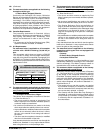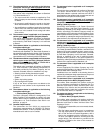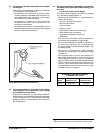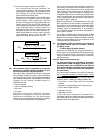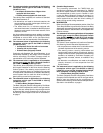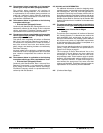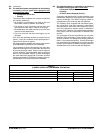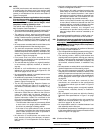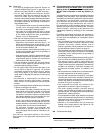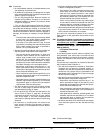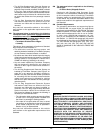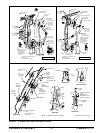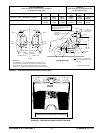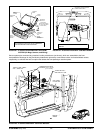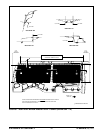
E-SERIES (May, 2004)26
E-SERIES (May, 2004) 27
STATEMENTS OF CONFORMITY
• The Air Bag Supplemental Restraint System as
originally installed (see Figure E on page 33), is not
removed, relocated, altered, or modied in any way.
• The Air Bag Supplemental Restraint System
Information Labels that are afxed to the front sun
visors are visible, and not altered, modified, or
removed. If the Air Bag Supplemental Restraint System
Information Labels are not afxed to the front visors
but shipped in dunnage, the following is necessary to
meet Standard 208:
– The information label must be permanently afxed
to each visor in an upright position readable from
the driver’s or passenger’s seating position.
– If the label is not visible when the visor is stored
(up position), an Air Bag Alert Label shall be placed
on the visible surface of the visor as specied in
Section 4.5.1(c) of Standard 208.
• After the front seats and B-pillar trim are installed, the
seat belt system components must comply with:
– Adjustment requirements specified by s7.1 as
these requirements apply to seat belt t, to the
intersection of the upper torso belt with the lap belt,
and to child seat lockability, and
– Latch mechanism requirements specied by s7.2
as these requirements apply to the accessibility of
seat belt components, and
– Latch plate access, retraction, seat belt guides, and
hardware requirements specied by s7.4 as these
requirements apply to comfort and convenience
requirements of the seat belt system.
• The seat hardware including the seat back frames
are free of sharp edges to prevent damage to the
seat belt webbing during an impact.
• Do not obstruct the E-Series seat belt path in the
area of “Point A” (Figure C, page 32). All seat belt
contactable surfaces must be free of burrs, parting
lines, sharp edges, or any other impediment that
could impair or damage the seat belt in load bearing
situations.
• No alteration or modifications are made to the
body chassis (including front bumper), drivetrain,
body mounts, or front suspension from the B-pillar
forward.
• Any front overhead console installed on an Incomplete
E-Series is congured as follows:
– Front header (full width) overhead consoles may
extend down no more than 2 inches as measured
from the Ford installed headliner† and extend
rearward no more than 6 inches as measured from
the midpoint between the Ford installed sun visor
inboard retaining clips (vehicle centerline).
– Center roof mounted consoles may extend down
no more than 3 inches as measured from the Ford
installed headliner† and width is limited to 8 inches
(4 inches either side of the vehicle centerline).
– All overhead consoles are designed and
manufactured to provide friendly surfaces on all
sides and edges which could be contacted by an
occupant.
Any seat belt assemblies added to this vehicle
must conform to the applicable requirements of this
Standard.
208 (Continued)
208 The statements below are applicable to the incomplete
E-Series Van with seat delete option, if the GVWR is
3856 kg [8,500 lb] or less and the Unloaded Vehicle
Weight, when completed, is 2495 kg [5,500 lb] or
less:
A seat delete option includes (does not delete) front seat
pedestals, front seat tracks, front seat belt and buckle
assemblies mounted to the seat tracks, restraint system,
and fasteners, and comes with a temporary transit
seat. Because the permanent seats to be installed
by a subsequent stage manufacturer are critical to
the performance of the completed vehicle and to the
dynamic test requirements of Standard 208, Occupant
Crash Protection, conformity to this Standard is not
substantially affected by the design of this incomplete
vehicle.
Ford offers the following information and guidelines to
assist subsequent stage manufacturers who choose
to install front seat assemblies in Incomplete E-Series
Van vehicles.
• The completed front seat assemblies include the
following Ford Motor Company components: Seat
pedestal, seat tracks, restraint system, and all
fasteners provided, and the fasteners are torqued to
the specications listed in Figure B on page 31.
• The completed front seat assemblies, when installed,
will have the same location, construction, and spatial
relationship to the seating system as provided by
Ford Motor Company.
• The Unloaded Vehicle Weight exceeds 2166 kg [4775
lb] for the E150 and 2268 kg [5000 lb] for the E250.
• The steering column, steering intermediate and
coupling shaft, steering wheel, steering gear, steering
linkage, related structural components, and attaching
hardware, as installed by Ford Motor Company, are
not removed, relocated, altered, or modied in any
way.
• No components are added which could inuence the
rearward displacement of the steering column.
• The seat belt components installed by Ford Motor
Company are not removed, relocated, or altered. If the
seat belt components are temporarily removed for any
reason, they must be reinstalled to the specications
as shown in Figure A on page 30.
• The completed front seats are installed to the
specications as shown in Figure B on page 31.
• The seats, seating hardware, seat belt warning
system, and all attaching hardware are installed in
accordance with, and comply with, this Standard and
Standard 207, Seating Systems.
• The completed front seats, when installed, are located
within the dimensional specications for the Seating
Reference Point and the torso angle is positioned as
specied in Figure C on page 32.
• Window or roof modifications do not exceed the
dened cut out areas shown in the Figures G1, G2
and G3 on pages 34, 35, and 36.
208 (Continued Next Page)
† The Headliner Plane is dened on Figure G3 page 36, for E-Series
vehicles without the Ford headliner.



